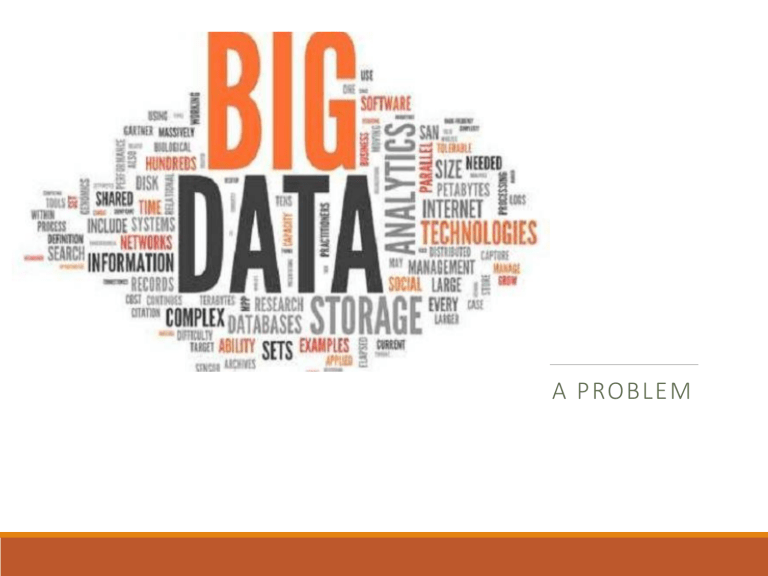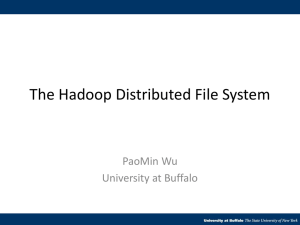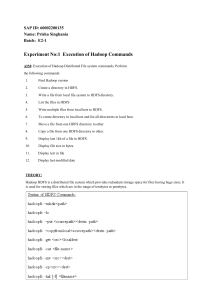
A PROBLEM BIG DATA Big data is a term for data sets that are so large or complex that traditional data processing application softwares are inadequate to deal with them. Challenges include capture, storage, analysis, search, sharing, transfer, visualization, querying, updating and information privacy. The term "big data" often refers simply to the use of predictive analytics, user behavior analytics, or certain other advanced data analytics methods that extract value from data, and seldom to a particular size of data set. WHY BIG DATA? o o o o o Over 2.5 Exabyte(2.5 billion gigabytes) of data is generated every day. Following are some of the sources of the huge volume of data: A typical, large stock exchange captures more than 1 TB of data every day. There are around 5 billion mobile phones (including 1.75 billion smart phones) in the world. YouTube users upload more than 48 hours of video every minute. Large social networks such as Twitter and Facebook capture more than 10 TB of data daily. There are more than 30 million networked sensors in the world. 4V’s BY IBM � � � � Volume Velocity Variety Veracity IBM’s definition Volume:- Big data is always large in volume. It actually doesn't have to be a certain number of petabytes to qualify. If your store of old data and new incoming data has gotten so large that you are having difficulty handling it, that's big data. Remember that it's going to keep getting bigger. IBM’s definition � Velocity :-Velocity or speed refers to how fast the data is coming in, but also to how fast we need to be able to analyze and utilize it. If we have one or more business processes that require real-time data analysis, we have a velocity challenge. Solving this issue might mean expanding our private cloud using a hybrid model that allows bursting for additional compute power asneeded for data analysis. IBM’s definition � Variety:- Variety points to the number of sources or incoming vectors leading to databases. That might be embedded sensor data, phone conversations, documents, video uploads or feeds, social media, and much more. Variety in data means variety in databases – we will almost certainly need to add a non-relational database if you haven't already done so. IBM’s definition � Veracity :-Veracity is probably the toughest nut to crack. If we can't trust the data itself, the source of the data, or the processes we are using to identify which data points are important, we have a veracity problem. One of the biggest problems with big data is the tendency for errors to snowball. User entry errors, redundancy and corruption all affect the value of data. We must clean our existing data and put processes in place to reduce the accumulation of dirty data going forward. Types of Data Structured data: � Data which is represented in a tabular format � E.g.: Databases Semi-structured data: � Data which does not have a formal data model � E.g.: XML files Unstructured data: � Data which does not have a pre-defined data model � E.g.: Text files Structured Data � � � Structured data refers to kinds of data with a high level of organization, such as information in a relational database. When information is highly structured and predictable, search engines can more easily organize and display it in creative ways. Structured data markup is a text-based organization of data that is included in a file and served from the web. Semi-structured data � � � It is a form of structured data that does not conform with the formal structure of data models associated with relational databases or other forms of data tables. But nonetheless contains tags or other markers to separate semantic elements and enforce hierarchies of records and fields within the data. Therefore, it is also known as self-describing structure. In semi-structured data, the entities belonging to the same class may have different attributes even though they are grouped together. Unstructured data � � � It refers to information that either does not have a pre-defined data model or is not organized in a predefined manner. It is typically text-heavy, but may contain data such as dates, numbers, and facts as well. This results in irregularities and ambiguities that make it difficult to understand using traditional programs as compared to data stored in fielded form in databases or annotated (semantically tagged) in documents. HISTORY � � � � The genesis of Hadoop came from the Google File System paper that was published in October 2003. This paper spawned another research paper from Google – MapReduce: Simplified Data Processing on Large Clusters. Development started on the Apache Nutch project, but was moved to the new Hadoop subproject in January 2006. Doug Cutting, who was working at Yahoo! at the time, named it after his son's toy elephant. WHAT IS HADOOP � � � � Hadoop is an open source, Java-based programming framework that supports the processing and storage of extremely large data sets in a distributed computing environment. It is part of the Apache project sponsored by the Apache Software Foundation. It consists of computer clusters built from commodity hardware. All the modules in Hadoop are designed with a fundamental assumption that hardware failures are common occurrences and should be automatically handled by the framework. The core of Apache Hadoop consists of a storage part, known as Hadoop Distributed File System (HDFS), and a processing part which is a MapReduce programming model. Core components of Hadoop � � Hadoop Distributed File System (HDFS) – a distributed file-system that stores data on commodity machines, providing very high aggregate bandwidth across the cluster. Hadoop MapReduce – an implementation of the MapReduce programming model for large scale data processing. HADOOP ECOSYSTEM CORE COMPONENTS-HDFS � � � � � � Hadoop File System was developed using distributed file system design. It runs on commodity(PCs which can be used to make a cluster ) hardware. Unlike other distributed systems, HDFS is highly fault tolerant and designed using low-cost hardware. HDFS holds very large amount of data and provides easier access. To store such huge data, the files are stored across multiple machines. HDFS also makes applications available to parallel processing. Features of HDFS � � � � � It is suitable for the distributed storage and processing. Hadoop provides a command interface to interact with HDFS. The built-in servers of namenode and datanode help users to easily check the status of cluster. Streaming access to file system data. HDFS provides file permissions and authentication. HDFS Architecture HDFS Architecture NAMENODE HDFS follows the master-slave architecture and it has the following elements. � Node - Commodity servers interconnected through a network device � � The namenode is the commodity hardware that contains an operating system and the namenode software. It is a software that can be run on commodity hardware. NAMENODE � � � � The system having the namenode acts as the master server and it does the following tasks: Manages the file system namespace. Regulates client’s access to files. It also executes file system operations such as renaming, closing, and opening files and directories. DATANODE � � � The datanode is a commodity hardware having any operating system and datanode software. For every node (Commodity hardware/System) in a cluster, there will be a datanode. These nodes manage the data storage of their system. Datanodes perform read-write operations on the file systems, as per client request. They also perform operations such as block creation, deletion, and replication according to the instructions of the namenode. Racks BLOCK � � Generally the user data is stored in the files of HDFS. The file in a file system will be divided into one or more segments and/or stored in individual data nodes. These file segments are called as blocks. In other words, the minimum amount of data that HDFS can read or write is called a Block. The default block size is 128MB, but it can be increased as per the need to change in HDFS configuration.




